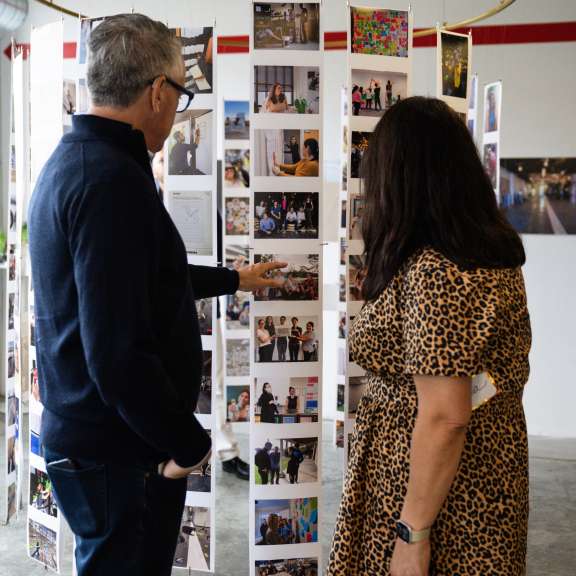The state of human-centered design
4 challenges to scaling human-centered design in government today

In 2013, the launch of HealthCare.gov was a wake-up call for government services. The website’s high-profile crash left millions of Americans frustrated and exposed the urgent need for better design and delivery of public systems. Its eventual rescue, led by a small team of designers and technologists, showed what was possible when systems were built with people’s needs at the center.
Around this time, I was beginning to chase after a belief that public services could be redesigned to better serve people. That belief became Civilla. In the beginning, Civilla wasn’t much more than an ambitious idea in a storage closet. But my cofounders Adam and Lena, and I shared the belief of creating a more beautiful civil society through public-serving institutions. One that has human-centered design at its core.
Bringing HCD into government
In those early years, it felt like an uphill battle to make the case to government teams about the importance of HCD. But slowly, a movement began to take shape. Groups inside government like the U.S. Digital Service, 18F, and city innovation labs began publishing resources and partnering with institutions to deliver real-world proof points. Outside of government, nonprofits like Civilla and Code For America and new technology vendors like the members of the Digital Services Coalition helped support governments as they began adopting this new way of working. Together, we showed that HCD wasn’t just a “nice to have”—it was a game-changer.
The next pivotal moment was the pandemic. COVID put extraordinary pressure on government services and drew attention to how resilient (or not) they were. This accelerated the adoption of HCD, not just as a tool but as an approach to better meet the needs of the public and frontline staff.
In 2024, the landscape looks very different than it did in its early stages. Bringing human-centered design into public services has always been a long game — work measured not in months or years but in decades. As Civilla approaches the end of its first 10 years, I’m encouraged by a noticeable shift in how government leaders are engaging with HCD.
Broadly speaking, human-centered design is now a widely known term. The questions we hear from leaders have evolved — from asking why human-centered design is important to how it can become central to the way their teams and agencies work.
From Civilla’s experience, I see four main barriers to institutions moving to the next level of adopting human-centered design.
1. The pressure to “boil the ocean”
Today, there are lots of top-down mandates to do customer experience work in government. In their excitement to put those mandates into practice, leaders can feel pressure to “boil the ocean” — taking on way too much too fast. Projects are often too big, take on too many HCD initiatives at once, or try to train everyone at the same time.
Change in institutional systems is hard, and you can’t jump in and change the whole thing at the same time. Leaders must start small — acknowledging that the problems at hand are sitting in a wider system and wider culture. The fastest way to get to systems change with HCD will actually be through a series of smaller, more targeted steps.
2. Internal staff doesn’t have the needed tools or capacity
Mandates from the top are a good start, but the managers who are responsible for carrying out HCD work don’t currently have the tools to work in this way.
HCD is a deep practice that takes time to learn. Leaders have to invest in developing the capacity of internal team members to carry out work in a new way. This can involve 1) hiring people with existing HCD skill sets or 2) building the capacity of existing team through in-depth training.
For leaders looking to go with option 2, it’s important to know that training isn’t something that can happen in a 3-day workshop. Building HCD capacity requires support and coaching over a sustained period of time while people build new skills and apply them to active projects.
3. Institutional cultures don’t naturally support human-centered design
HCD is not just a process change; it's a culture change. HCD fundamentally reshapes and reorients the way that people see and go about their work. While some methods, like Lean Process Improvement, are additive, HCD is disruptive to the way work is typically done in institutions. It’s easy for leaders to say they want it, but a lot harder to actually commit to reorienting institutional cultures to make it possible.
In addition to culture change, leaders must consider the very real structural barriers to the adoption of HCD, such as the ability for staff to interview end users (eg. the Paperwork Reduction Act) or provide monetary compensation to interviewees. These things are easily overlooked, which can create a lot of frustration when teams hit the ground running and get stuck before they even start.
4. Finding vendors that can deliver on HCD promises
Vendors play an important role in supporting leaders as they make the shift to HCD. However, with all of the mandates coming from the top, some vendors are offering human-centered design services without doing the work themselves to make it a core competency of the company.
Many large vendors have bought up smaller HCD firms, hoping to integrate their skills without providing the internal culture that is needed for them to thrive. Or, they subcontract the HCD work out as a phase of a project rather than a central operating philosophy. In these cases, HCD shows up on paper but not in impact. In the long run, this can be harmful to the multi-decade project of incorporating HCD into how public-serving institutions function.
There’s a lot of hype about HCD right now. But if vendors and institutions continue over-promising and under-delivering, the impact will not play out over time. People will start to question the efficacy of the process, rather than the quality of the work itself.
Moving from optimism to implementation
To put this evolution into perspective, we can map it with Nielsen Norman Group’s maturity model graph. Right now, we’re in what we’d call the “emergent” or optimism stage for HCD in government.

It’s a huge improvement to where we were in 2015, when HCD was largely absent from institutional work. Emerging proof points are promising, but HCD has not yet become fully adopted by public-serving institutions. If we cannot demonstrate impact and follow through on the promises of HCD, we run the risk of momentum burning out and people losing trust.
In Michigan, we’ve seen the transformative power of committing to human-centered design. In 2015, Civilla helped reimagine the longest public benefits application in the country, creating a version that was 80% shorter and could be completed by 90% of applicants in 20 minutes or less. The redesign cut processing times by nearly 50% and reduced the time caseworkers spend correcting errors by 60%. Today, Michigan still uses this streamlined application to make critical services more accessible.
Since then, Michigan has expanded its HCD efforts to improve the entire public benefits journey, from renewals and online enrollment to policy and processes. Other state agencies have also embraced HCD to enhance services like higher education and DMV renewals. Building on this success, Civilla is now bringing similar innovations to Missouri, Washington, and Connecticut.
The question now is whether government leaders can build on proof points like these to make human-centered design a cornerstone of public service. This requires courage, focus, and action — starting small, building capacity, and reshaping institutional culture to prioritize people’s needs. Leaders must champion HCD not as a one-off initiative but as a lasting commitment to better governance.
I’m optimistic that it can happen. This next year has the potential to be a turning point for institutions to become more responsive, efficient, and oriented toward the needs of the public. The time to act is now — before the momentum fades. Civilla looks forward to supporting more courageous leaders to continue that work in 2025 and beyond.
- Michael J. Brennan


